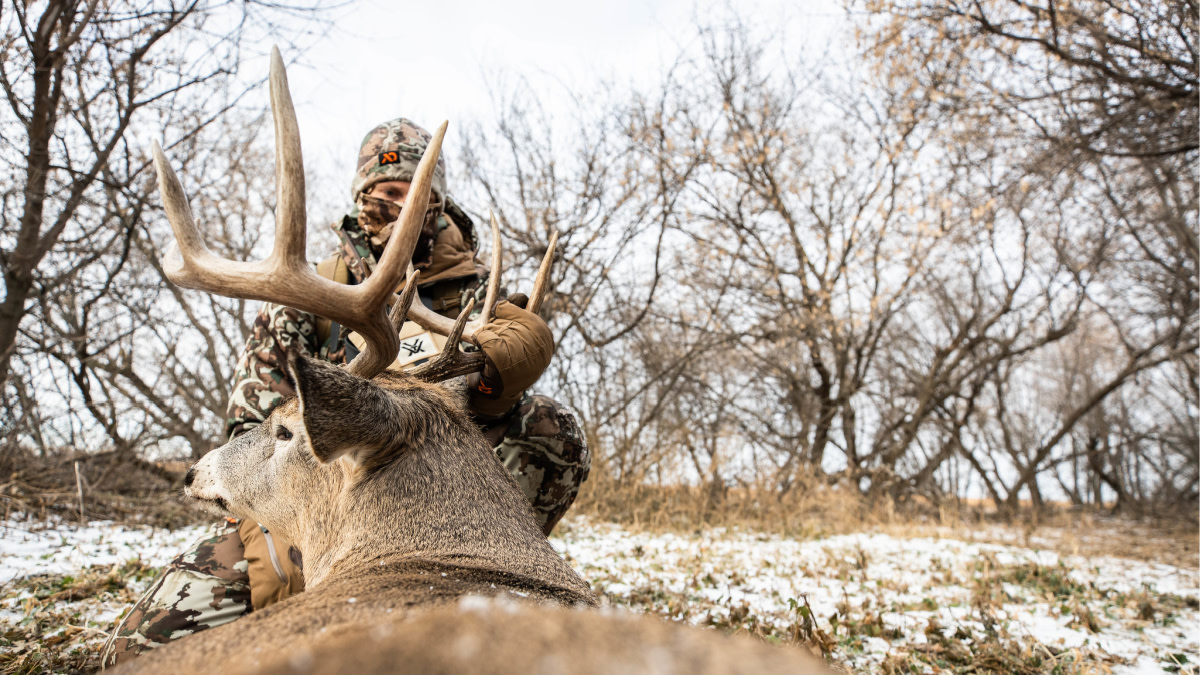
“Reaping” has been one of the hottest trends in the turkey hunting world over the last decade. The practice involves a hunter crawling towards a gobbler while concealed by a tail fan until the tom comes in to fend off the perceived challenger. The result is a close-range shot at a fired-up turkey.
A similar tactic is now finding its way into the whitetail woods, leading to highly effective and intense hunts. Here’s how a handful of innovative and gutsy deer hunters have been using a variation of this strategy to reap whitetail bucks.
The Setup
While turkey hunters use a simple tail fan as a decoy and to cover their movement, the deer hunting version of this is a silhouette buck decoy. Several different companies make these two-dimensional decoys, such as Montana Decoy and Heads Up Decoy, but most include the image of a buck printed on fabric stretched across a frame and then attached to a hunter’s bow or staked in the ground.
While some deer hunters use portable decoys to help conceal their movements during still hunts, the most common use is related to the very specific scenario of spotting a buck paired up with a doe. As many of us have witnessed, when a love-drunk, testosterone-fueled mature buck is locked on a doe, he has only two things on his mind—staying close to that doe and fending off competition. The goal of a whitetail reaper is to take advantage of the latter tendency by posing as an intruder moving in to steal a buck’s lady.
“We’ll find these big ones that are locked down with does and we’ll take this decoy in towards them,” explained Jared Scheffler of Whitetail Adrenaline on a past episode of the Wired to Hunt Podcast. “We’ve seen the best results by sneaking in as close as we can without them ever seeing the decoy, get in position, and then try to get that buck to come and run you off.”
Once you’ve closed as much distance as possible, considering wind direction and minimizing sound, then it’s just a matter of getting the buck to see the decoy. Tony Trietch, another bowhunter who’s found success with this setup, will sometimes rattle or grunt to get a buck’s attention. But if he can get close enough, he’d prefer to not even do that.
“It usually doesn’t take much; just flashing that decoy often works,” Trietch said. “He’ll look at you, look at the other buck, pin his ears back, and come over. With the older, mature bucks, if they see that decoy, they’re coming in.”
Shot Challenges
While it’s clear that the whitetail reap can get a buck to come into range, it also presents certain challenges for getting shots. Different than shooting a deer that’s passing by while heading to some other destination, a reaped whitetail buck is coming directly toward the decoy and the hunter behind it. Because of this, both Trietch and Scheffler have found that head-on shots are common and often necessary to execute before a buck realizes he’s been duped.
“They’ll keep walking to you. Eventually they’re going to get to a point, whether they’re at 10 yards or 10 feet, where they’re going to realize you’re not a buck,” Treitch said. “So, you’ve got to shoot them before that.”
Frontal shots, while certainly lethal, leave less room for error than a traditional broadside angle. For this reason it’s recommended that you practice specifically for this shot and only proceed if you’re confident in your abilities. If you’re not comfortable with this shot, the whitetail reap might not be a tactic worth pursuing.
Safety Concerns
While Trietch and Scheffler’s success with this tactic is intriguing, it must be noted that the practice of reaping a buck is inherently dangerous and should not be attempted without thorough consideration of the consequences.
“They’re coming to kick your ass. They’re not trying to go around you—they’re coming right to you,” remarked Trietch.
It should go without saying that posing as a buck and challenging a mature deer could potentially lead to a charge and an injury. This risk must be taken into account.
“From behind that decoy, it’s dangerous,” Scheffler said. “But our philosophy is that so is rock climbing and a lot of other things you can do, so we’re willing to accept that risk. But it sure is a rush, and it can be effective.”
Another final word of warning, whether on public or private land, do not attempt this type of practice during gun season when a distant hunter might mistake your decoy for a live deer.
To Reap or Not?
The whitetail reap is fascinating, potentially dangerous, and seemingly effective in the right situations. While I’m not sure that I’d recommend this to others or even try it myself, I’m certainly intrigued by the possibilities and impressed by the results. Consider me an admirer from afar.
Feature image via Captured Creative.





